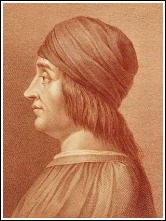It was one of the oldest references to a deck with 22 trumps, other earlier documents do suggest, that Trionfi cards were handled before in 5x13 (Lucca-Tarocchi), 5x14 (Bembo-14, Ferrarese documents of 1441 and 1457) or 5x16-structure (Cary-Yale). From this it might be suspected, that Count Boiardo possibly invented this structure, which finally developed to be the standard representation of the Tarocchi- or Tarot-game.
The number 22 inside the game of Tarot much later caused the suggestions of Count de Mellet and Eliphas Levi, who claimed, that Tarot developed in context to kabbalistic ideas in relation to the 22 letters of the Hebrew alphabet. This suggestions did take a dominant influence upon modern Tarot, especially as specific astrological ideas connected to the Hebrew alphabet in the manner of the prekabbalistic Sepher Yetzirah were now related to individual Tarot trumps.
Here we've the question, if Boiardo (in the case, that he really was the first, who used this scheme for a Trionfi deck), was influenced by Hebrew contemporaries to choose just the number 22 for his trumps.
they have forty cards in this game ...
... Love, Hope, Jealousy, and Fear
are the passions, and a tercet have the cards,
in order not to leave, who plays, in error."
(The contents of the Boiardo chapter were started in 2003 by the cooperation of the members of the Boiardo group: Jane Cocker, Mari Hoshizaki, Raimondo Luberti, Ross Gregory Caldwell, autorbis - later cooperated Huck Meyer, Ross Caldwell and Marco [Dr. Arcanus] to finish the poem translation)
